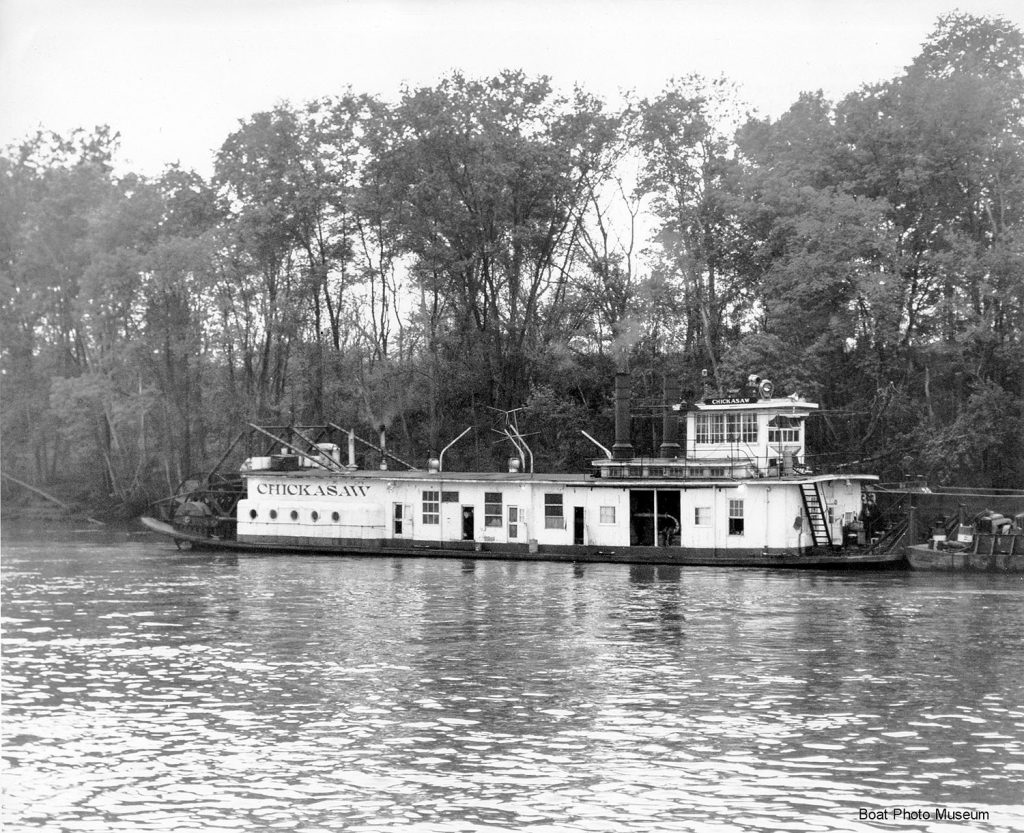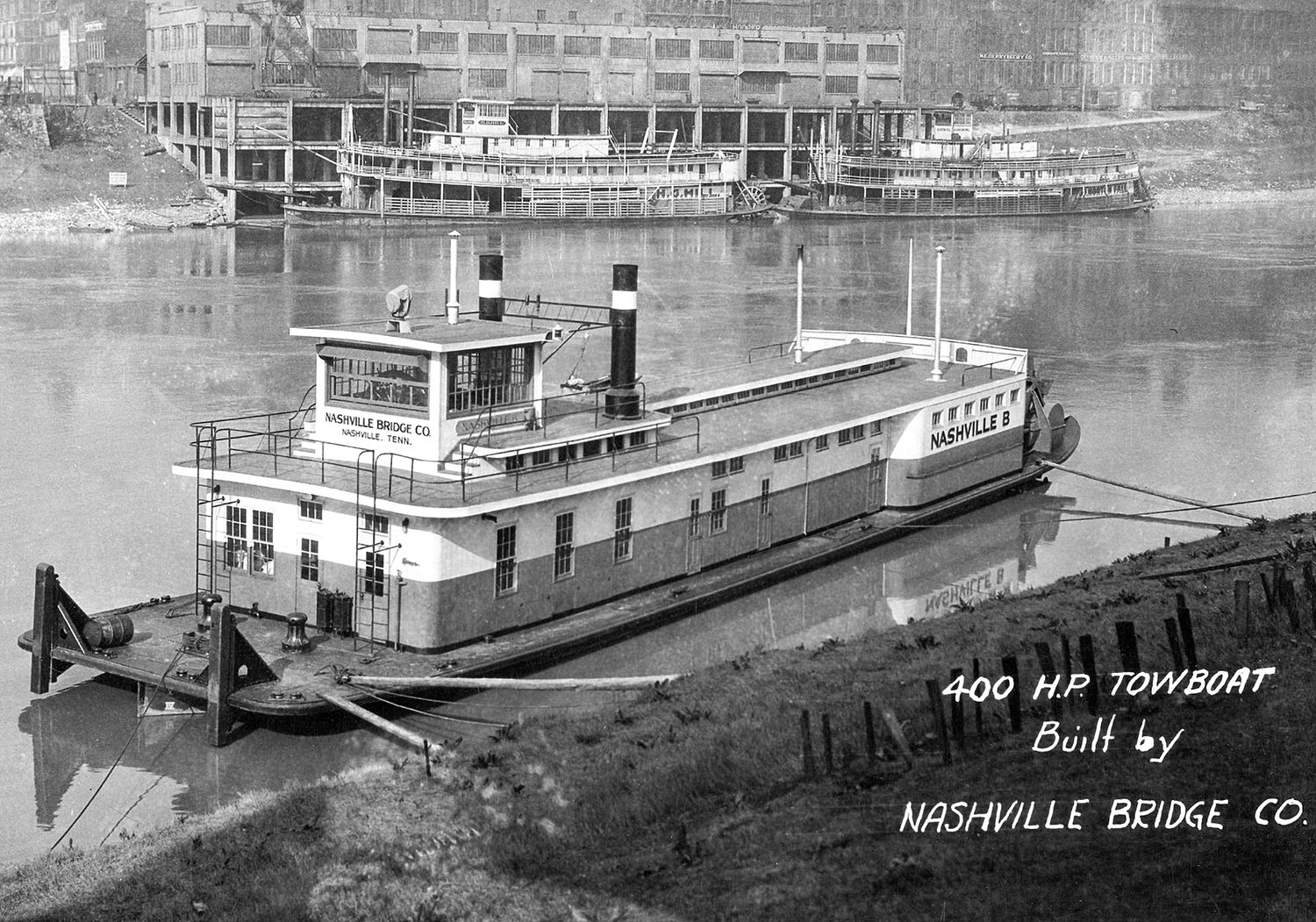In 1902, Arthur J. Dyer bought out his partner’s interests in the H.T. Sinnot Company and formed the Nashville Bridge & Construction Company. According to the Tennessee Encyclopedia, Dyer was an 1891 graduate of Vanderbilt Engineering School and had worked for several bridge companies before entering a partnership with Sinnot. Following another reorganization in 1903 or 1904 it became known as the Nashville Bridge Company (Nabrico). It was headquartered in downtown Nashville, and as the name implied it was focused on the building of bridges, and in particular those that moved, such as bascule-type bridges.
In 1915, the firm constructed a small floating derrick hull for the U.S. Engineers, and this would mark a shift in the company toward marine construction. In 1923 Nabrico built the sternwheel towboat Harvey (WJ February 12, 2021) for T.L. Herbert & Son. This 240 hp. boat was recognized as being the first fully diesel boat built for the inland rivers. In 1925 and 1926, respectively, Nabrico delivered the twin-prop diesel boats Kosmortar and Kings Landing to the Kosmos Portland Cement Company (WJ May 22, 2023).
In 1926, the same year they delivered the “modern” twin-screw Kings Landing, Nabrico built a towboat for stock, one not ordered by a specific buyer, but on speculation. This boat was sternwheel and had a steel hull that was 111 by 29.4 feet, much wider than most diesel sternwheelers of the time. This could have been because it was equipped with two independent sternwheels, each powered by a 200 hp. Winton diesel engine. The 400 total horsepower also made it among the most powerful of diesel sternwheel towboats. The boat had a single main cabin of predominantly wooden construction and a large pilothouse with multi-paned window sash above that. Two smokestacks were positioned behind the pilothouse, and skylights ran the length of the cabin roof. The name selected for this stock towboat was appropriately Nashville B.
The Nashville B remained under the ownership of Nashville Bridge for several years. In 1931, the List of Merchant Vessels shows a change of owners to the Tennessee Coal, Iron & Railroad Company of Birmingham, Ala., and the name was changed to Chickasaw. The Tennessee Coal, Iron & Railroad Company, known locally as TCI and also simply as the Tennessee Company, had been in existence since 1852, and in 1907 was merged into the United States Steel Corporation.
The Chickasaw was taken from Nashville, Tenn., on the Cumberland River to the Tombigbee and Warrior rivers, having to follow a circuitous route to New Orleans and through open water to Mobile as the Gulf Intracoastal Waterway had not been built. U.S. Steel later formed a subsidiary called Warrior & Gulf Navigation Company (W&G), and the Chickasaw was placed under that concern. W&G continued to operate the stocky sternwheeler until 1948. W&G had acquired the twin-prop steam towboat Dwight F. Davis (WJ August 15, 2022) from Federal in 1947, converted it to diesel and placed the name Chickasaw on it. The sternwheel Chickasaw was then sold to Triangle Towing Company, Maysville, Ky.
Triangle retained the name Chickasaw on the boat, and it became a fixture towing petroleum on the mid-Ohio River. About 1955, it was sold to C.E. Tinsley and R. Stilwell, operating as T&S Towing Company, Tobinsport, Ind. It was then working in the sand and gravel trade on the mid to lower Ohio River. In 1958, T&S removed the original 400 hp. Worthington diesels on the Chickasaw, replacing them with a pair of Cat D397 diesels and Snow-Nabstedt reduction gears. It was then rated at 900 hp.

In the spring of 1965, the Chickasaw was sold to White Brothers Inc., Belle, W.Va., who utilized it in construction work on the Upper Ohio and Kanawha rivers. In 1968, it was dismantled at Witcher, W.Va., on the Kanawha River. The Cat D397 engines were placed on the Jennie A. Greene, which White Bros. had acquired from the R.W. Greene Sand & Gravel Company of Louisville, Ky. It had been built by Dravo in 1940 as the Ductillite for Wheeling Steel, and White Bros. would rename it Juanita White in 1969.
At some point after being dismantled, the Chickasaw sank at the White landing below the mouth of Witcher Creek, Mile 71 on the Kanawha River. Due to being not far above the Marmet Locks and Dam, the water there is relatively deep, and the boat sank out of sight. After another vessel was holed by coming in contact with it, the upper works were torn off with a crane and clamshell bucket. The remainder of it still lays where it sank.
Caption for top photo: New at Nashville. Note the packets H.G. Hill and Jo Horton Fall in the background. (Dan Owen Boat Photo Museum collection)
Capt. David Smith can be contacted at davidsmith1955obc@gmail.com.




